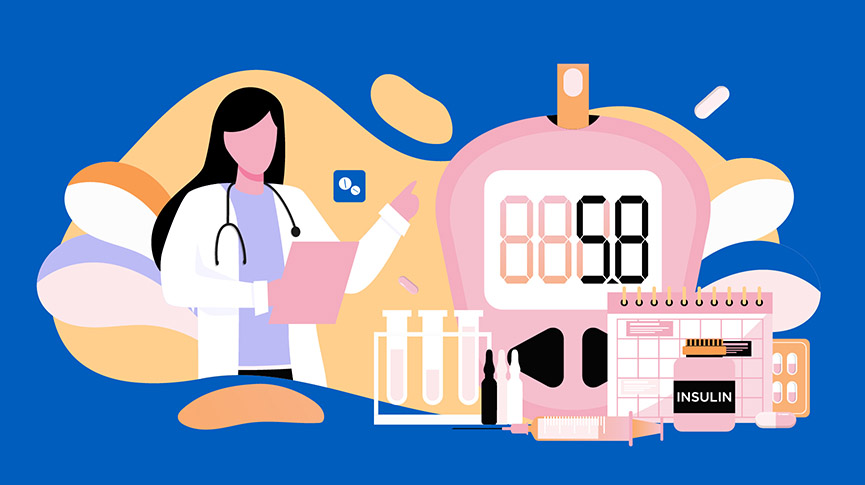Diabetes in Women: The Low Down on High Blood Sugar

About 10 million women in the United States have diabetes. As many as one quarter do not even know they have it. Knowing more about diabetes can help you identify if you are at risk and help you prevent or delay its onset.
What is diabetes?
With many myths surrounding diabetes, it’s important to understand the facts about this serious disease. Having diabetes means that your blood glucose (sugar) is too high. A chronic disease that cannot be cured once you have it, diabetes is a serious health condition.
Your body uses glucose for energy – it’s the fuel that keeps you going – but too much glucose is bad for your body.
Most of the food you eat is turned into glucose, which is then taken into the cells around your body through the help of insulin. Insulin is a hormone made in the pancreas, an organ near the stomach. If your body doesn’t make enough insulin or the insulin doesn’t work correctly, the glucose cannot get into the cells and therefore stays in the blood. This makes your blood glucose high, causing you to have diabetes.
Pre-diabetes is the name used to describe the stage between normal blood sugar levels and diabetes. Early detection and management of pre-diabetes can slow down or even prevent the onset of full blown diabetes.
There are three main types of diabetes:
Type 1 Diabetes is usually diagnosed in children and young adults. An autoimmune condition, it occurs when the pancreas no longer makes insulin because the body’s immune system has attacked and destroyed cells in the pancreas. People with type 1 diabetes must take insulin by injection or with an insulin pump. The cause is unclear and it cannot be prevented.
Type 2 Diabetes is the most common type in adult women: itoccurs when your body doesn’t make enough insulin or doesn’t respond to it properly. This form of diabetes is caused by a combination of genetic and environmental factors.
Gestational Diabetes is a type of diabetes that occurs during pregnancy and usually disappears after delivery. It occurs in about 1 in 20 pregnancies. Women who have had gestational diabetes are more at risk of developing type 2 diabetes later in life.
What are the symptoms of diabetes?
Diabetes may not present itself with any warning signs at all. Or you may have some of these signs:
- Increased thirst
- Increased hunger
- Fatigue
- Increased urination, especially at night
- Weight loss
- Blurred vision
- Sores that don’t heal
- Tingling or numb feet or hands
- Frequent vaginal infections, including yeast infections
What complications are caused by diabetes?
Patients with diabetes have higher death rates than people who do not have diabetes regardless of sex, age, or other factors. Some of the complications that people with diabetes face include:
- Heart Disease and Strokes
- Eye Complications
- Kidney Disease
- Nerve Damage
- Foot Problems
- Skin Complications
- Dental Disease
Diabetes can cause specific complications in women:
Women with diabetes are at particularly high risk for heart problems. There is a significantly higher risk for urinary tract infections among women with diabetes, as well as an increased risk of recurrent yeast infections. The changes in estrogen and other hormonal levels that occur during perimenopause can cause major fluctuations in blood glucose levels.
Those with diabetes also face an increased risk of premature menopause, which can lead to higher risk of heart disease. Women with diabetes should also be aware that certain types of medication can affect their blood glucose levels. For example, some birth control pills can raise blood glucose levels.
What are the risk factors for diabetes?
The risk factors for type 1 diabetes are not known. In the United States, high-risk factors for type 2 diabetes include:
- Weight – being overweight through poor diet and lack of exercise is a primary risk factor for type 2 diabetes.
- Family history — having a mother, father, brother, or sister with diabetes.
- Race— Although it’s unclear why, people of certain races — including of African, Hispanic, Asian and Native American decent — are more likely to develop type 2 diabetes than Caucasians/Europeans are.
- High blood pressure — 140/90 mmHg or higher. Both numbers are important. If one or both numbers are usually high, you have high blood pressure.
- High cholesterol — total cholesterol over 240 mg/dL.
- Inactivity — the less active you are, the more at risk you are of developing diabetes.
- Age — after the age of 45 your risk increases.
- Gestational diabetes — If you developed gestational diabetes when you were pregnant, your risk of later developing type 2 diabetes increases. If you gave birth to a baby weighing more than 9 pounds (4 kilograms), you’re also at risk of type 2 diabetes.
- Having other health conditions that are linked to problems using insulin, like polycystic ovarian syndrome (PCOS)
What can I do to reduce my risk of developing diabetes?
If you are among those at higher risk, consider getting screened for diabetes by making an appointment to see your family doctor. They will be able to carry out a test to measure your blood sugar levels. This type of test usually requires that you don’t eat for 8 hours beforehand; your doctor will advise you if you need to fast. Write down any symptoms you have, even if they seem unrelated.
Early discovery of an insulin problem is key. Even if you have been diagnosed with pre-diabetes, a major research study conducted by the American College of Sports Medicine and the American Diabetes Association has shown that fullblown type 2 diabetes can possibly be prevented or delayed by focusing on improving the environmental risk factors.
Women in the study lowered their intake or fat and calories, and exercises for 30 minutes a day, 5 times a week. The results showed that physical activity and moderate weight loss lowered type 2 diabetes risk by up to 58% in high-risk populations.
If you are among those at risk of diabetes, these lifestyle changes are important – not only will you be leading a healthier life; you can help delay or prevent the development of this serious disorder.

A collective group of “lady experts” at Intimina who love sharing our personal experiences, even when they are a little too personal. We believe it’s time to start breaking down the taboos around menstruation, motherhood, and menopause, and start owning our female health.



I have tested at home 7 on two separate days is it possible I have diabetes I am a 78 year old woman